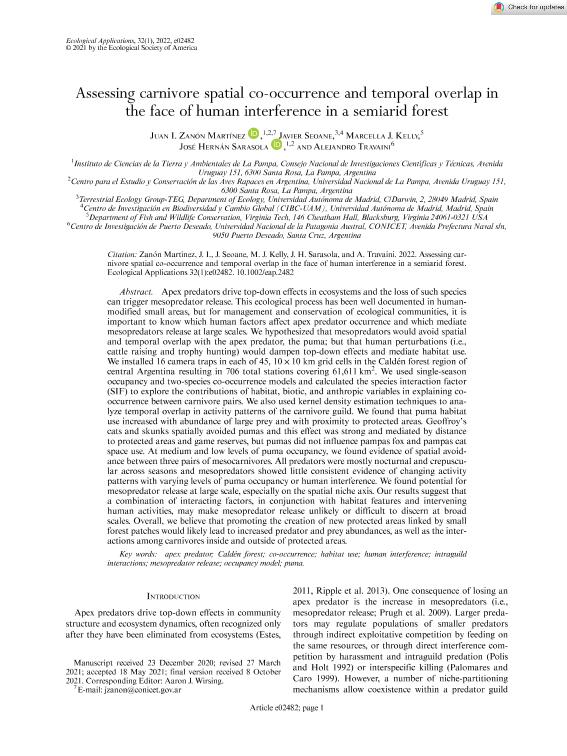Mostrar el registro sencillo del ítem
dc.contributor.author
Zanón Martínez, Juan Ignacio

dc.contributor.author
Seoane, Javier

dc.contributor.author
Kelly, Marcella J.
dc.contributor.author
Sarasola, José Hernán

dc.contributor.author
Travaini, Alejandro

dc.date.available
2022-04-11T15:38:39Z
dc.date.issued
2021-10-21
dc.identifier.citation
Zanón Martínez, Juan Ignacio; Seoane, Javier; Kelly, Marcella J.; Sarasola, José Hernán; Travaini, Alejandro; Assessing carnivore spatial co‐occurrence and temporal overlap in the face of human interference in a semi‐arid forest; Ecological Society of America; Ecological Applications; 32; 1; 21-10-2021; 1-18
dc.identifier.issn
1051-0761
dc.identifier.uri
http://hdl.handle.net/11336/154912
dc.description.abstract
Apex predators drive top-down effects in ecosystems and the loss of such species can trigger mesopredator release. This ecological process has been well documented in human-modified small areas, but for management and conservation of ecological communities, it is important to know which human factors affect apex predator occurrence and which mediate mesopredators release at large scales. We hypothesized that mesopredators would avoid spatial and temporal overlap with the apex predator, the puma; but that human perturbations (i.e. cattle raising and trophy hunting) would dampen top-down effects and mediate habitat use. We installed 16 camera traps in each of 45, 10x10-km grid cells in the Caldén forest region of central Argentina resulting in 706 total stations covering 61,611km2. We used single-season occupancy and two-species co-occurrence models and calculated the species interaction factor (SIF) to explore the contributions of habitat, biotic, and anthropic variables in explaining co-occurrence between carnivore pairs. We also used kernel density estimation techniques to analyze temporal overlap in activity patterns of the carnivore guild. We found that puma habitat use increased with abundance of large prey and with proximity to protected areas. Geoffroy´s cats and skunks spatially avoided pumas and this effect was strong and mediated by distance to protected areas and game reserves, but pumas did not influence pampas fox and pampas cat space use. At medium and low levels of puma occupancy, we found evidence of spatial avoidance between 3 pairs of mesocarnivores. All predators were mostly nocturnal and crepuscular across seasons and mesopredators showed little consistent evidence of changing activity patterns with varying levels of puma occupancy or human interference. We found potential for mesopredator release at large scale, especially on the spatial niche axis. Our results suggest that a combination of interacting factors, in conjunction with habitat features and intervening human activities, may make mesopredator release unlikely or difficult to discern at broad scales. Overall, we believe that promoting the creation of new protected areas linked by small forest patches would likely lead to increased predator and prey abundances, as well as the interactions among carnivores inside and outside of protected areas.
dc.format
application/pdf
dc.language.iso
eng
dc.publisher
Ecological Society of America

dc.rights
info:eu-repo/semantics/openAccess
dc.rights.uri
https://creativecommons.org/licenses/by/2.5/ar/
dc.subject
Mesopredator release
dc.subject
Puma abundance
dc.subject
Human impacts
dc.subject
Occupancy model
dc.subject
Caldén forest
dc.subject.classification
Conservación de la Biodiversidad

dc.subject.classification
Ciencias Biológicas

dc.subject.classification
CIENCIAS NATURALES Y EXACTAS

dc.title
Assessing carnivore spatial co‐occurrence and temporal overlap in the face of human interference in a semi‐arid forest
dc.type
info:eu-repo/semantics/article
dc.type
info:ar-repo/semantics/artículo
dc.type
info:eu-repo/semantics/publishedVersion
dc.date.updated
2022-04-07T21:03:57Z
dc.identifier.eissn
1939-5582
dc.journal.volume
32
dc.journal.number
1
dc.journal.pagination
1-18
dc.journal.pais
Estados Unidos

dc.description.fil
Fil: Zanón Martínez, Juan Ignacio. Consejo Nacional de Investigaciones Científicas y Técnicas. Instituto de Ciencias de la Tierra y Ambientales de La Pampa. Universidad Nacional de La Pampa. Facultad de Ciencias Exactas y Naturales. Instituto de Ciencias de la Tierra y Ambientales de La Pampa; Argentina. Universidad Nacional de La Pampa. Facultad de Ciencia Exactas y Naturales. Departamento de Recursos Naturales. Centro para el Estudio y Conservación de Aves Rapaces; Argentina
dc.description.fil
Fil: Seoane, Javier. Universidad Autónoma de Madrid; España
dc.description.fil
Fil: Kelly, Marcella J.. Virginia Tech University; Estados Unidos
dc.description.fil
Fil: Sarasola, José Hernán. Consejo Nacional de Investigaciones Científicas y Técnicas. Instituto de Ciencias de la Tierra y Ambientales de La Pampa. Universidad Nacional de La Pampa. Facultad de Ciencias Exactas y Naturales. Instituto de Ciencias de la Tierra y Ambientales de La Pampa; Argentina. Universidad Nacional de La Pampa. Facultad de Ciencia Exactas y Naturales. Departamento de Recursos Naturales. Centro para el Estudio y Conservación de Aves Rapaces; Argentina
dc.description.fil
Fil: Travaini, Alejandro. Universidad Nacional de la Patagonia Austral. Unidad Académica Caleta Olivia. Centro de Investigaciones Puerto Deseado; Argentina. Consejo Nacional de Investigaciones Científicas y Técnicas; Argentina
dc.journal.title
Ecological Applications

dc.relation.alternativeid
info:eu-repo/semantics/altIdentifier/url/https://onlinelibrary.wiley.com/doi/10.1002/eap.2482
dc.relation.alternativeid
info:eu-repo/semantics/altIdentifier/doi/https://doi.org/10.1002/eap.2482
Archivos asociados
